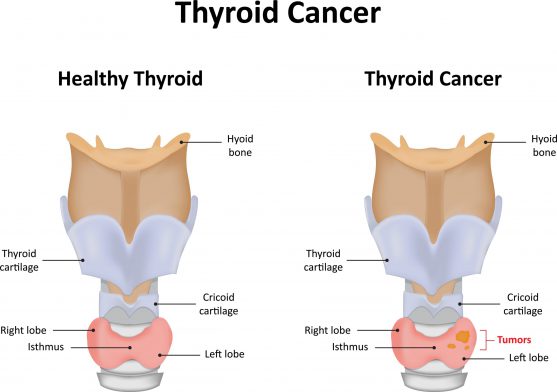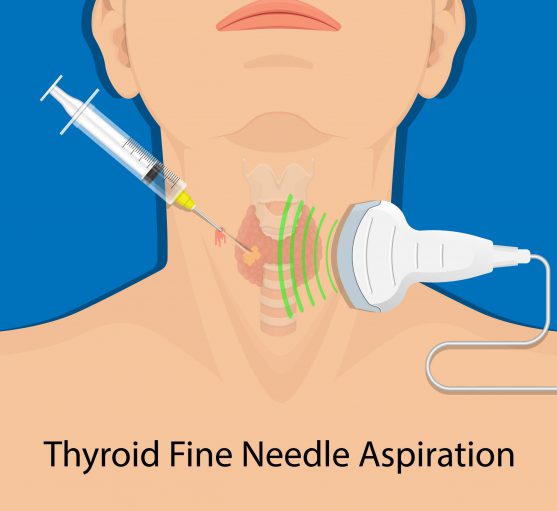The thyroid gland is a butterfly-shaped gland situated at the base of the neck just below the Adam’s apple.
This gland produces thyroxine (T4), triiodothyronine (T3), and calcitonin hormones. These hormones control the body’s metabolism and regulate several other functions, such as using energy, producing heat, consuming oxygen, regulating heart rate, blood pressure, etc.
Due to many reasons, the normal thyroid tissue may sometimes overgrow, leading to the development of one or more thyroid nodules. This may look like a lump on the neck. Thyroid nodules are one of the common endocrine conditions and may indicate a cyst, iodine deficiency, or cancer.
What are thyroid nodules?
According to the American Thyroid Association (ATA), the thyroid nodules are solitary, fluid-filled, or solid lumps that develop within the thyroid gland.
Thyroid nodules are usually asymptomatic (without symptoms) unless they become large and are sometimes visible as a lump.
Most nodules are identified during a routine health examination, or incidentally during an imaging test for some other condition.
Are all thyroid lumps dangerous?
In about 90% of cases, thyroid nodules are harmless. However, in 4% to 6.5% of cases, it can turn out to be cancerous.

In adults, a physical examination alone may indicate the prevalence of 5% to 7% thyroid nodules and an ultrasound may indicate a prevalence of 20% to 76% of thyroid nodules.
The exact reason behind the thyroid nodules is unknown, but factors such as aging, having a family history of thyroid nodules, being female (5 times more risk than males), having an iodine deficiency, or having a history of radiation therapy on the neck may increase the risk of thyroid nodules.
What symptoms do thyroid lumps create?
The signs and symptoms of the thyroid nodules may depend on the pressure they exert on the nearby organs, and the under or over production of the hormones.
As the thyroid nodules become large, they may put pressure on the windpipe or food pipe and may cause the following symptoms:
- Hoarseness in voice
- Difficulty in breathing or swallowing
- Neck or throat pain
In cases where the thyroid nodule produces too much thyroid hormone, the patients may experience symptoms of excessive function of thyroid called hyperthyroidism.
Similarly, in cases where the thyroid nodule causes suppression of thyroid hormone production, the patients may experience symptoms of underfunctioning of thyroid called hypothyroidism.
Are there different types of thyroid lumps?
The following are the most common types of thyroid nodules:
-
Single thyroid nodule (solitary nodules)
These are the common presentation of thyroid lumps which may include benign lesions that usually don’t require treatment or cancerous lesions which often require some form of treatment with either surgery, radioactive iodine or both. If the nodule causes overproduction of thyroid hormones, then treatment is needed with either drug therapy, radioactive iodine, or surgery.
-
Multiple thyroid nodules (Multinodular goitre)
It comprises multiple thyroid nodules that can be either small or large. Surgical treatment is not required unless they cause any problem, such as rapidly growing nodules, difficulty in swallowing or breathing.
-
Diffuse goitre
It refers to an enlarged thyroid gland. The most common cause of goitre is the lack of iodine in the diet. It can be associated with either over- or underproduction of thyroid hormones. Autoimmune conditions, such as Hashimoto’s thyroiditis and Graves’ disease can also cause diffuse enlargement of thyroid.
What are the reasons for thyroid lumps?
The exact cause for development of thyroid nodules is unknown, the following condition may be responsible for tissue growth in the thyroid forming a lump:
- Thyroid cyst
- Thyroid adenoma
- Toxic adenoma
- Hashimoto’s disease
- Hyperthyroidism
- Iodine deficiency
- Cancer
What is the difference between a thyroid nodule and thyroid cancer?
Thyroid nodules are abnormal tissue growths that can be cancerous or non-cancerous. Only 1 in 20 thyroid nodules are cancerous. But, most often thyroid cancer begins with a lump in the thyroid gland.
Therefore, a detailed examination is required to differentiate between non-cancerous thyroid nodules and thyroid cancer, and initiate the treatment accordingly during the early stage.
What tests are done to know if the thyroid lump is cancerous?
Initially, a physical examination of the thyroid gland is done, to check if there is a single nodule or multiple nodules inside the gland.
For a more detailed diagnosis,the following tests are recommended:
-
TSH (Thyroid-stimulating hormone) test
It is a type of blood test to determine the level of thyroid-stimulating hormone that regulates thyroid functioning.
It is not possible to determine whether the thyroid nodule is cancerous or non-cancerous only with a physical examination and TSH test. Therefore, the following specialized tests are recommended:
-
Thyroid ultrasound scan
It is a key tool to identify thyroid nodules. This test uses high-frequency sound waves to produce images of the lower neck, to check for nodules and determine if they are solid or fluid-filled and identify other characteristics that help assess the risk of cancer in the thyroid nodule.
-
FNAC (Fine Needle Aspiration Cytology)
In this procedure, a hollow needle is inserted inside the thyroid gland to collect a small sample of cells from the thyroid nodule. This aspirated cells are examined in the laboratory to look for any abnormalities.

-
Nuclear thyroid scan
In this procedure, radioactive iodine is given to the patient either orally, or through an intravenous injection. The patient is then advised to lie on the back with the chest and neck positioned under the scanner to capture clear images of the thyroid gland or thyroid tumor deposits on the monitor.
How is a thyroid lump treated?
Watchful waiting may be an option, if the thyroid nodule is non-cancerous. This includes monitoring the nodule or lump over a period of time, to see if the nodule goes away on its own, stays the same size, or increases in size.
In this phase, regular physical examination, ultrasound, and thyroid scans are advised. If the nodule begins to grow, a biopsy is recommended.
However, if the nodule remains unchanged treatment is not required.
If the thyroid function tests show an abnormal result i.e. if the thyroid gland is not producing sufficient thyroid hormone, then thyroid hormone therapy may be recommended.
In some cases, if the nodule is too large and causing difficulty with swallowing or breathing then surgery may be performed to take off the pressure.
Surgery is also done in case of large multinodular goiters, especially if the nodule is constricting the airways, the oesophagus, or the blood vessels.
In some cases, radioactive iodine is used to treat hyper-functioning of the thyroid nodule. Radioactive iodine is given orally either in the form of a capsule or liquid to shrink the thyroid nodules.
In the case of thyroid cancer:
Surgery is the most common treatment option for the removal of cancerous thyroid nodules. Previously, near-total thyroidectomy (removal of the whole thyroid gland) was considered to be the standard treatment for thyroid cancer.
However, today there are several surgeries that involve a limited removal of the thyroid tissue, based on the type and size of cancerous nodule. After the surgical procedure, the patient is advised to take levothyroxine throughout life to supplement thyroid hormone.
In case, if cancerous thyroid nodules are small and favorable, then alcohol ablation may be considered with close follow up. Alcohol ablation is a technique, in which the thyroid nodule is destroyed by injecting a small amount of alcohol into it.
Radioactive Iodine ablation may be required in addition to surgery for some patients presenting with locally advanced disease or advanced disease.
Thyroid nodules, depending on their underlying cause can be harmless or harmful, therefore, it is important that timely medical attention is sought. When diagnosed on time, most thyroid nodules can be diagnosed well, and treated effectively.
Dr Sanjay Sen answers patient questions on thyroid cancer here.


